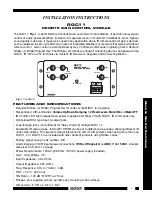
OLIMEX© 2020
MOD-IO user's manual
MOD-IO provides 4 relays with proper connector that allow the switching of circuits. The board is also
equipped with 4 optocouplers (also known as opto-isolators) that transfer electrical signals between two
isolated circuits by using light. MOD-IO also has 4 analog inputs won a connector.
MOD-IO comes with built-in firmware which makes the usage of the board's peripherals much easier. It
uses a standard I2C communication and several commands are defined. The source of the firmware is also
available to the customer.
Customers have full access to the technical documentation of the board. The software is released under
General Purpose License and the board is considered open-hardware – all schematics and board design
files are available to the customer under the Creative Commons Attribution-ShareAlike 3.0 Unported
License.
1.3 Board variants
A smaller variant of the MOD-IO2 board is the MOD-IO2 one. It has 2 relays (compared to the 4 of the
MOD-IO) and uses Microchip's PIC16 microcontroller (compared to the Atmel's ATmega16).
MOD-IO2 is also stackable and again comes with custom firmware for easier start. It uses I2C for
communication.
MOD-IO2 is also a completely open design – hardware files and firmware sources are available to the
customer.
1.4 Board version used in the manual
Hardware revision A1 boards and resources were used while writing this document. It is possible that they
are not the same hardware revision at your side so it is always recommended to download the latest
sources from the product page of the board
(
https://www.olimex.com/Products/Modules/IO/MOD-IO/open-source-hardware
1.5 Document organization
Each section in this document covers a separate topic, organized as follows:
–
Chapter 1 is an overview of the board usage and features
–
Chapter 2 provides a guide for quickly setting up the board and software notes
–
Chapter 3 contains the general board diagram and layout
–
Chapter 4 describes the component that is the heart of the board: the ATmega16A microcontroller
–
Chapter 5 covers the connector pinout, peripherals and jumper description
–
Chapter 6 provides the schematics and the dimensions of the board
–
Chapter 7 contains the revision history, useful links and support information
Page 6 of 30







































